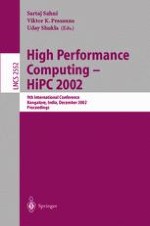2002 | Buch
High Performance Computing — HiPC 2002
9th International Conference Bangalore, India, December 18–21, 2002 Proceedings
herausgegeben von: Sartaj Sahni, Viktor K. Prasanna, Uday Shukla
Verlag: Springer Berlin Heidelberg
Buchreihe : Lecture Notes in Computer Science
Enthalten in: Professional Book Archive
